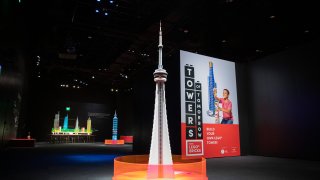
Perot Museum of Nature and Science’s “Towers of Tomorrow with LEGO Bricks” is on view through April 24.
The Perot Museum of Nature and Science is inspiring visitors to build their future one LEGO brick at a time with Towers of Tomorrow with LEGO Bricks, an interactive exhibition now on view at the Dallas museum through April 24.
“When we look at what exhibits we can bring in, what traveling exhibitions, we want to spark those ‘ah-ha’ moments,” said Jessica Chavez, the museum’s Chief Learning Officer. “We want students and adults alike to see themselves in STEM careers.”
The traveling exhibition features models of 20 iconic skyscrapers from around the world. Ryan McNaught, one of only 21 LEGO certified professionals in the world, built the towers using more than 500,000 bricks. In a video introduction, McNaught and his team describe how they spent more than 2,000 hours recreating these landmarks at 1:200 scale.
McNaught uses the same LEGO bricks found at toy stores, layering different colors of bricks to create the iridescent quality of shimmering glass. His team carefully studies several photographs and plans of the buildings to understand the engineering challenges and to recreate distinctive architectural features. One model features interior landscaping, mimicking the actual landscaping of the real-life building.
Get DFW local news, weather forecasts and entertainment stories to your inbox. Sign up for NBC DFW newsletters.
The featured towers include American treasures such as the Willis (Sears) Tower in Chicago, the Wilshire Grand Centre in Los Angeles, the Bank of America Plaza in Atlanta, and a miniature New York City with 111 West 57th Street, Central Park Tower Building, the Chrysler Building, and the Empire State Building.
International landmarks include the Burj Khalifa in Dubai, the Barangaroo Hotel Crown Resort in Sydney, the Infinity Tower in Brisbane, the CN Tower in Toronto, the Tokyo Skytree in Tokyo, and the Marina Bay Sands in Singapore. “It gives a little passport to the world,” Chavez said.
The Scene
Each tower is accompanied by a description of the actual building and specific challenges of creating the LEGO version. Burj Khalifa model required 48,365 bricks and was too tall to fit in McNaught’s workshop. Instead, the team built it in five tiers and assembled it in a car park. For the Empire State Building, McNaught used dinosaur claws in front of knights’ shields to reference King Kong and the building’s Art Deco ornamentation.
Marina Bay Sands in Singapore has a skypark that resembles a boat perched on top of sloping towers. Creating the banana-shaped curves with rectangular 26,400 LEGO bricks was McNaught’s greatest challenge. McNaught’s team decided to build the model of the Petronas Towers in Malaysia upside-down because they wanted the studs facing downwards so the glass bricks appear clean and sharp. It took the team 360 hours to build the model.
“You can come more than once and still learn something new,” Chavez said.
These LEGO models are meant to inspire people to see what they can create. The exhibition includes interactive stations with thousands of LEGO bricks. “With this exhibit, we really want to encourage those to think about their own towers of tomorrow, so we have over 200,000 blocks to do that,” Chavez said.
The museum also displays the models that visitors create. Chavez noticed children are more patient than adults when they encounter a challenge while creating a structure. “We’ll come in and we’ll see kids here for 45 minutes to an hour, just tinkering and designing and that’s what we want to encourage: that iterative process of it didn’t work out but how can we keep it going and redesign and tinker,” Chavez said.
The Perot Museum hopes these simple building blocks transformed into soaring creations will encourage an interest in careers like engineering, construction, and architecture. “When we think of STEM careers and pathways, we want them to know the sky is not the limit,” Chavez said.